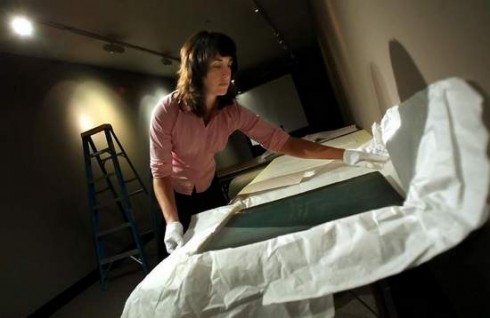Cothran ’01 Discovers Rare 1870s Photography Book
A recent article in the Tennessean highlighted a notable discovery at Nashville’s Parthenon Museum: a rare and complete copy of William J. Stillman’s 1870 photographic book, The Acropolis of Athens, Illustrated Picturesquely and Architecturally in Photography.

Registrar and Assistant Curator Brenna Cothran ’01 came across it as part of an ongoing four-year-old project of inventorying every item in storage as other duties permitted. She told Tennessean journalist Janell Ross that when she saw the book, which had been stashed away in a storage room drawer, “The hair on my arms stood up. It was kind of this adrenaline rush.”
Stillman, an American painter, photographer, journalist, and diplomat had published this work at a time when photography was, one might say, in its adolescence, and tourism had just begun to flourish. Nineteenth- and early early-2oth century admirers of Stillman’s work often removed the pages of the album to frame and hang on their walls. Thus, finding a complete copy of his book is highly unusual and the museum set about raising funds to cover the cost of conserving and restoring it.
Now, the back story. The reason Cothran immediately knew this was an exceptional find: her Wesleyan education—specifically classes with Professor Andy Szegedy-Maszak, who admits, “I guess I talked a bit about William James Stillman, about whom I’ve written a fair amount.” Stillman was a natural subject for the Classical Studies professor who, with his wife, writer Elizabeth Bobrick, has assembled a noteworthy collection of photographs, a number of which have recently been on exhibit at the Getty Museum and were exhibited in 1998 at Wesleyan’s Davison Art Center.
Additionally, Cothran’s find has also served to reconnect the former student with Szegedy-Maszak her former professor. “She wrote me immediately,” he says, “and we’ve been back in touch ever since.” Recently she notified him that the Tennessean article sparked the interest of a donor who has agreed to underwrite the entire cost of restoring the album. “The whole thing is pretty cool,” Szegedy-Maszak says.
Cothran agrees: “When I took art history, Latin literature, and other humanities classes at Wesleyan, I took them for the love of learning. At the time, I never imagined that just a few years later, I would be lucky enough to have a job that allowed me to put what I learned to use. This experience has highlighted for me the value of the education I got at Wesleyan.”

